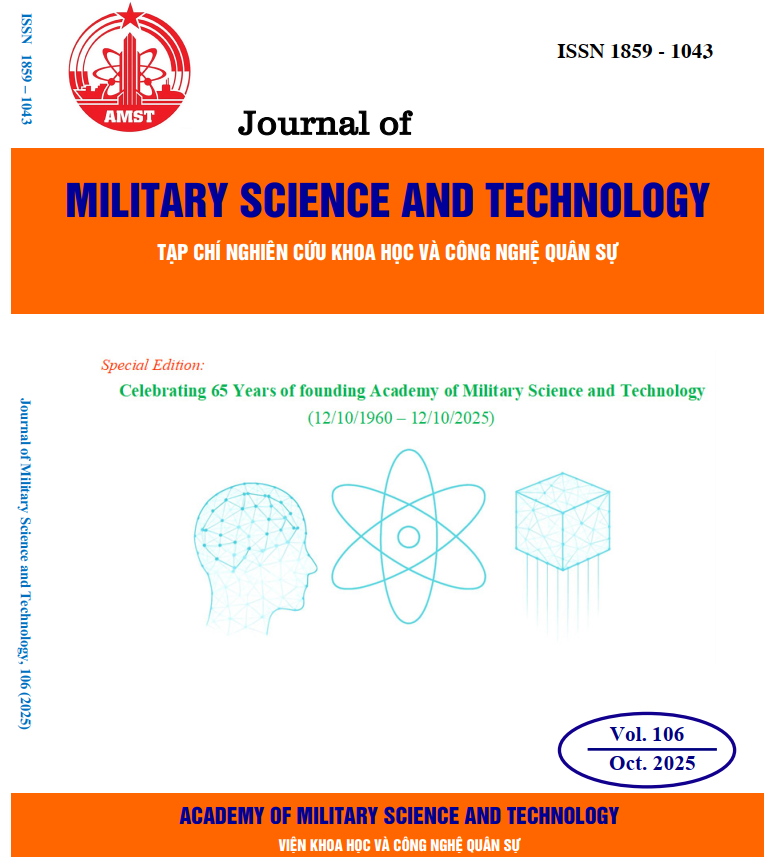Study on the removal capability of trinitrotoluene in water using the UV/WO₃/H₂O₂ photo oxidation method
DOI:
https://doi.org/10.54939/1859-1043.j.mst.106.2025.94-101Keywords:
Tungsten trioxide; Photo-oxidation; Trinitrotoluene; Treatment.Abstract
The paper presents the results of synthesizing WO₃ by the chemical precipitation method, along with an evaluation of its physicochemical properties, morphology, crystal structure, and chemical characteristics. In addition, preliminary results are introduced regarding the removal efficiency of TNT from aqueous solution by photocatalytic oxidation, in which •OH and h+ play the main role as oxidizing species. The results indicate that the synthesized WO₃ possesses a hexagonal crystal structure, a density of 7.920 g/cm³, an absorption intensity of 1.45 a.u at a wavelength of λ = 285 nm, and a band gap energy of approximately 3.3 eV. The protonation process favors the widening of the energy band gap and enhances the oxidation potential of WO₃, thereby improving its photocatalytic performance and increasing its ability to absorb UVB light. The UV/WO₃/H₂O₂ photocatalytic oxidation process, with a fixed H₂O₂ concentration of 2.94 × 10⁻³ M, an optimal catalyst dosage of 300 mg WO₃, and a UV lamp power of 10 W, achieved a TNT removal efficiency of 98.7% at an initial concentration of 100 mg/L after 60 minutes of reaction under ambient temperature.
References
[1]. Ayoub, K., et al. "Application of advanced oxidation processes for TNT removal: A review", Journal of Hazardous Materials, 178(1–3), 10–28, (2010).
[2]. Ye, Z., Zhao, Q., et al. "Acute toxicity evaluation of explosive wastewater by bacterial bioluminescence assays using a freshwater luminescent bacterium, Vibrio qinghaiensis sp. nov", Journal of Hazardous Materials, 186(2–3), 1351–1354, (2011).
[3]. Flokstra, B. R., et al. "Microtox toxicity test: detoxification of TNT and RDX contaminated solutions by poplar tissue cultures", Chemosphere, 71(10), 1970–1976, (2008).
[4]. Zhang, Y., et al. "Photocatalytic treatment of 2,4,6-trinitotoluene in red water by multi-doped TiO₂ with enhanced visible light photocatalytic activity", Colloids and Surfaces A: Physicochemical and Engineering Aspects, 452, 103–108, (2014).
[5]. Zhu, Q., Zhang, Y., et al. "Cuprous oxide created on sepiolite: preparation, characterization, and photocatalytic activity in treatment of red water from 2,4,6-trinitrotoluene manufacturing", Journal of Hazardous Materials, 217–218, 11–18, (2012).
[6]. Bueno, P. R., et al. "SnO₂, ZnO and related polycrystalline compound semiconductors: An overview and review on the voltage-dependent resistance (non-ohmic) feature", Journal of the European Ceramic Society, 28(3), 505–529, (2008).
[7]. Eroi, S. N., et al. "Heterogeneous WO₃/H₂O₂ system for degradation of Indigo Carmin dye from aqueous solution", South African Journal of Chemical Engineering, 37, 53–60, (2021).
[8]. Chu, W., et al. "Photocatalytic oxidation of monuron in the suspension of WO₃ under the irradiation of UV–visible light", Chemosphere, 86(11), 1079–1086, (2012).
[9]. Kolhe, P., et al. "Facile hydrothermal synthesis of WO₃ nanoconifer thin film: multifunctional behavior for gas sensing and field emission applications", Journal of Inorganic and Organometallic Polymers and Materials, 29, (2019).
[10]. Tahir, M. B., et al. "Nanostructured-based WO₃ photocatalysts: recent development, activity enhancement, perspectives and applications for wastewater treatment", International Journal of Environmental Science and Technology, 14(11), 2519–2542, (2017).
[11]. Muzaffar, T., et al. "Synthesis and characterization of WO₃/GO nanocomposites for antimicrobial properties", Journal of Cluster Science, 33(5), 1987–1996, (2022).
[12]. Makuła, P., et al. "How to correctly determine the band gap energy of modified semiconductor photocatalysts based on UV–Vis spectra", Journal of Physical Chemistry Letters, 9(23), 6814–6817, (2018).
[13]. Sánchez-Martínez, D., et al. "Nanostructured-based WO₃ photocatalysts: recent development, activity enhancement, perspectives and applications for wastewater treatment", in: García-López, E. I., Palmisano, L. B. (Eds.), Studies in Photocatalysis, Elsevier, 211–220, (2021).
[14]. Jeyapaul, T., et al. "Synthesis of WO₃ nanorods and their photocatalytic degradation of organic contaminants", Rasayan Journal of Chemistry, 11, 1405–1414, (2018).
[15]. Huo, N., et al. "Synthesis of WO₃ nanostructures and their ultraviolet photoresponse properties", Journal of Materials Chemistry C, 1(25), 3999–4007, (2013).
[16]. Yan, M., et al. "The fabrication of a novel Ag₃VO₄/WO₃ heterojunction with enhanced visible light efficiency in the photocatalytic degradation of TC", Physical Chemistry Chemical Physics, 18(4), 3308–3315, (2016).
[17]. Kouvelis, K., et al. "Photocatalytic degradation of Losartan with BiOCl/sepiolite nanocomposites", Catalysts, 14, 433, (2024).
[18]. Fadaei, A., et al. "Photocatalytic degradation of chlorpyrifos in water using titanium dioxide and zinc oxide", Fresenius Environmental Bulletin, 22(8), 2442–2447, (2013).
[19]. Augugliaro, V., et al. "Overview on oxidation mechanisms of organic compounds by TiO₂ in heterogeneous photocatalysis", Journal of Photochemistry and Photobiology C: Photochemistry Reviews, 13(3), 224–245, (2012).







